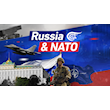Russian advance intensifies in Donbass as Sumy tensions rise
Russia doubles battlefield gains in Donbass as Ukraine fortifies Sumy with elite units, while analysts see a shift in momentum ahead of potential peace talks.
-

In this photo taken on May 27, 2025 and provided by Ukraine's 24th Mechanized Brigade press service, a soldier fires a 120mm mortar towards Russian army positions near Chasiv Yar, Donetsk region, Ukraine, Tuesday, May 27, 2025 (AP)
Ukrainian armed forces have deployed mechanized units, elite airborne assault formations, territorial defense groups, and border guards in the Sumy region near the Russian border, according to a report from the Russian Ministry of Defense cited by TASS on Thursday.
Kiev is said to have concentrated a significant combat force in the area, composed of mechanized brigades and elite air assault units. On the front lines, territorial defense troops and border guards from the 5th Border Detachment, reinforced by personnel from other border units, are currently active.
Among the deployed formations are a Ukrainian Army mechanized brigade, two assault regiments, and the Aidar Battalion, the latter banned in Russia and designated as a terrorist organization. According to Russian defense sources, the Aidar unit has been attempting offensive operations around the village of Ryzhivka in the Sumy region but has reportedly been suffering 30 to 40 casualties per day.
Russian momentum builds
Meanwhile, The New York Times reported that Russian forces are advancing across Ukrainian battlefields at the fastest pace seen this year following months of incremental progress. Analysts cited by the newspaper suggest that Moscow’s summer offensive may have already begun.
They believe Russian troops have launched a renewed effort to break through Ukrainian lines, even as Moscow enters its first direct peace talks with Kiev since 2022. In particular, Russian forces are pushing deeper into the eastern Donbass region, capitalizing on the winter lull to build up reserves, improve battlefield communications, and adapt their drone and attack tactics, according to military analysts.
Some Western analysts cited by the paper believe Russian President Vladimir Putin was leveraging the dry summer season, optimal for offensive operations, to gain ground and strengthen his negotiating position ahead of potential peace talks later this year. They argue that Russia, having held the advantage on the battlefield for much of the war, is now applying military pressure to extract political concessions.
Samuel Charap, a senior political analyst at the RAND Corporation specializing in Russian affairs, told The New York Times that Russia appeared committed to simultaneous military and diplomatic strategies. “Russia is accustomed to fighting and negotiating at the same time,” he noted, adding that Moscow had shown no indication of accepting European or Ukrainian calls for a ceasefire before securing terms favorable to its demands.
Gains double in April in Donetsk
This month, Russian forces reportedly doubled the territorial gains made in April, averaging 5.5 square miles per day, according to data from Deep State, a Ukrainian military-linked war tracking group. This marks Russia’s fastest rate of advance since November.
Most of the recent gains have occurred in Donetsk, one of the two Russian-speaking provinces that make up the Donbass region and remain central to the Kremlin’s territorial claims. This month, Russian troops reportedly broke through Ukrainian defenses between the besieged cities of Pokrovsk and Toretsk, advancing north toward the last remaining Ukrainian logistics hubs in the area.
According to Dmitry Kuznets, a military analyst with the independent Russian outlet Meduza, the offensive appears to be part of a broader campaign aimed at capturing the remaining Ukrainian-held areas of Donetsk by year’s end.
Smaller advances were also recorded in Sumy, north of the major city of Kharkov, with Russian troops reportedly regaining momentum after driving out Ukrainian forces who had previously crossed into parts of Russia’s Kursk region.
Russia to present peace memorandum in days
Russia has confirmed that a second round of direct negotiations with Ukraine will take place in Istanbul on June 2, with Moscow set to present a comprehensive peace memorandum outlining its terms for resolving the ongoing conflict.
Russian Foreign Minister Sergey Lavrov announced Wednesday that the Russian delegation, headed by presidential aide Vladimir Medinsky, is ready to hand over the document and explain its provisions during the talks. "The Russian side, as agreed, has promptly developed a relevant memorandum, which sets out our position on all aspects of reliably overcoming the root causes of the crisis," Lavrov said
"Our delegation, headed by Vladimir Medinsky, is ready to present this memorandum to the Ukrainian delegation and give the necessary explanations during the second round of resumed direct talks in Istanbul next Monday, June 2," he added.
Fragile Diplomacy
Ukraine, supported by its Western allies, continues to insist on a ceasefire as a prerequisite for any serious settlement discussion. Kiev has firmly rejected Russian demands for troop withdrawals from annexed territories or limitations on its future NATO alignment. European and US officials have expressed concern that Moscow is using diplomacy as a delaying tactic while continuing its military operations.
Meanwhile, tensions are escalating as Washington considers lifting restrictions on Ukraine's use of US-supplied weapons to strike targets inside Russian territory—a shift that would bring the US into alignment with the UK, France, and Germany. Kremlin officials have warned that such a move would mark a dangerous escalation and could undermine ongoing peace efforts.
Lavrov, in his statement, expressed gratitude to Turkey for hosting the talks and called on other international actors to support the renewed peace initiative. "Moscow expects those interested in the success of the peace process to support a new round of Russian-Ukrainian talks," he said.

 5 Min Read
5 Min Read










